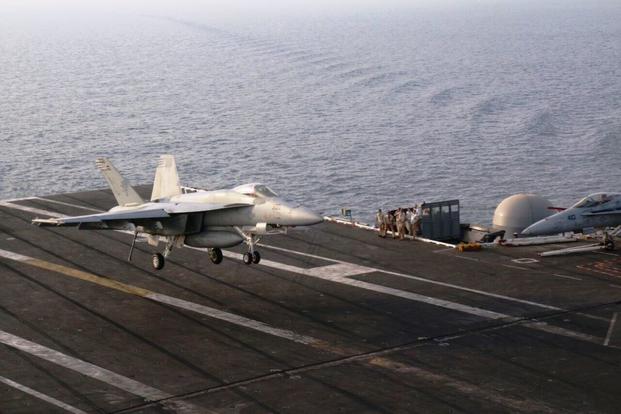ABOARD THE USS GEORGE H. W. BUSH, PERSIAN GULF -- After eight hours in the cockpit executing airstrikes on ISIS targets, fighter pilots assigned to this carrier are getting a little extra help as they come in for a landing.
The Norfolk, Virginia-based George H. W. Bush and the San Diego-based carrier Carl Vinson both deployed in January with air wings equipped with a developmental technology that allows them to better control lift, making landings safer and more precise.
How much more precise? So much, pilots attached to the ship told Military.com, that it's causing their arresting cables to wear unevenly.
The system, formerly known as Maritime Augmented Guidance with Integrated Controls for Carrier Approach and Recovery Precision Enabling Technologies, or MAGIC CARPET, is now called Precision Landing Modes. It uses what's called dynamic lift control to take some of the burden of last-minute, high-stakes adjustments off pilots, who can focus on their flight path in and let the aircraft adjust accordingly.
For Capt. James McCall, commanding officer of Carrier Air Wing 8 aboard the Bush, one of the key improvements to the status quo that Precision Landing Modes officers is the luxury of fewer power adjustments as the aircraft nears the carrier.
"When a pilot is landing an aircraft, if he wants to come down quicker, he's going to pull power, and if he wants to slow that down, he's doing to add power," McCall said. "As you get closer to the back end of the ship, any power-off correction tends to get folks' hair raised a little bit. Because, obviously, if that were to result in a large rate of descent, getting the engines to spool back up to do the other correction, reducing the rate of descent, it's not instantaneous."
With PLM flight control logic, the descending F/A-18 Hornet or E/A-18 Growler will use its flaps to help control rate of descent, allowing for a more consistent throttle speed and fewer manual corrections.
On the Bush, a Nimitz-class carrier, pilots have 786 feet of flight deck to work with, less than a tenth of a traditional runway length. But the requirements of landing are far more precise; pilots told Military.com they needed to fly the nose of the aircraft through a an imaginary box about one foot across in order to properly align their descent and snag a landing cable. On a dark night, Hornet pilots have described the experience of executing such a landing on a carrier as "emotional."
One pilot assigned to the wing's Strike Fighter Squadron 87, the Golden Warriors, which flies the F/A-18E Super Hornet, said the use of the new technology had caused accuracy rates to skyrocket -- so much so that the target arresting cable, usually the second of three on the Bush, was wearing out faster than the others and had to be rotated.
"We were statistically too accurate," said "JoJo," the training officer for VFA-87, who asked to be identified by his callsign.
Vice Adm. Mike Shoemaker, head of Naval Air Forces, said something similar last August about the carrier-variant F-35C, which was designed with native PLM technology, known in that platform as Delta Flight Path.
"They were landing in the same spot on the runway every time, tearing up where the hook touches down," he told a Washington, D.C. audience about field testing of the capability. "So we quickly realized, we needed to either fix the runway or adjust, put some variants in the system. So that's how precise this new system is."
Aboard the Bush, McCall said the system had reduced landing touchdown dispersion by about 50 percent, a remarkable improvement in accuracy. In April, he said, he sent an email message to the Navy's other air wing commanders, sharing the unit's findings about the system the positive impact it's had so far.
The system is currently planned for a 2019 full roll-out to Super Hornet and Growler squadrons across the Navy. McCall said the only element the current system lacked was full redundancy as a fail-safe.
"Because it doesn't have full redundancy, we still expect our youngest aviators to come out of our training pipeline and learn how to fly the jet manually, so they have a baseline to fall back on in case of some sort of aircraft malfunction," he said. "I do expect those requirements to change as the system is fully redundant."
PLM doesn't guarantee a perfect landing or take the pilot out of the game, however. During observation of daytime carrier landings May 3 and 4, Military.com saw at least one bolter, when an aircraft fails to snag an arresting hook, and multiple wave-offs, in which planes weren't correctly aligned in their approach and were told to circle and try again.
Nor does it take the fun out of flying, JoJo said. Only one pilot in the entire air wing didn't love the system, he said, and that pilot did not have much experience on it. Nostalgia for the old way of landing was essentially nonexistent, he said.
"We just think it's the greatest," he said. "It makes [landing] so easy and safe, and you're able to focus more on the tactical execution. I have no complaints."
-- Hope Hodge Seck can be reached at hope.seck@military.com. Follow her on Twitter at @HopeSeck.











